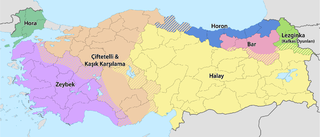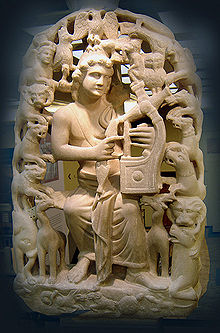
Sirtaki or syrtaki is a popular dance of Greek origin, choreographed by Giorgos Provias for the 1964 film Zorba the Greek. It is a recent Greek folkdance, and a mixture of the slow and fast rhythms of the hasapiko and hasaposerviko dance respectively. The dance and the accompanying music by Míkis Theodorakis are also called Zorbá's dance, Zorbas, or "the dance of Zorba".

The hasapiko is a Greek folk dance from Constantinople. The dance originated in the Middle Ages as a battle mime with swords performed by the Greek butchers' guild, which adopted it from the military of the Byzantine era. In Constantinople during the Byzantine times, it was called in Greek μακελλάρικος χορός. Some Greeks, however, reserve the latter term only for the fast version of the dance.

Antikristos or Antikrystós is a dance of Greek origin. “Aντικρυστός” in Greek language refers to the verb αντικρύζω “be across, opposite, face-to-face”. It is also known in Armenia. Antikristos, has similarities with karsilamas dance. It is danced in couples.

Zeibekiko is a Greek folk dance.

Kochari (Armenian: Քոչարի, is an Armenian folk dance.
"Misirlou" is a song from the Eastern Mediterranean region. The earliest known recording of the song is a 1927 Greek rebetiko / tsifteteli composition influenced by Middle Eastern music. There are also Arabic, Armenian, Persian, Indian, and Turkish versions of the song. This song was very popular from the 1920s in the Greek American and Armenian American communities who settled in the United States of America as part of the Ottoman Empire diaspora.

Karsilamas, is a folk dance spread all over Northwest Turkey and carried to Greece by Greek refugees. The term "karşılama" means "encounter, welcoming, greeting". The dance is popular on Northwestern areas of Turkey, especially on wedding parties and festivals.

Sousta is the name of a folk dance in Cyprus and Crete which is danced in Greece and generally in the Balkans. The music is generally played with a lyre, laouto, and mandolin.
The Tsamikos or Kleftikos is a popular traditional folk dance of Greece, done to music of 3/4 meter.

Greek folk music includes a variety of Greek styles played by ethnic Greeks in Greece, Cyprus, Australia, the United States and elsewhere. Apart from the common music found all-around Greece, there are distinct types of folk music, sometimes related to the history or simply the taste of the specific places.
Turkish folk dances are the folk dances of Turkey. Facing three seas, straddling important trade routes, Turkey has a complex, sophisticated culture, reflected in the variety of its dances. The dominant dance forms are types of line dance. There are many different types of folk dances performed in various ways in Turkey, and these reflect the cultural structure of each region. The Bar in Erzurum province, the Halay in the East and Southeast, the Hora in Thrace, the Horon in the Black Sea, Spoon dances in and around Konya and Lezginka in Kars and Ardahan are the best known examples of these.

Horon (Greek) or khoron, refers to a group of a circle folk dances from the Black Sea region of Turkey.

The Dance of Zalongo refers to the mass suicide of women from Souli and their children during the Souliote War at December 16, 1803. After being trapped by Ottoman Albanian troops, near the village of Zalongo in Epirus, modern Greece, then Ottoman Empire, c. 22 women decided to turn towards the cliff's edge together with their infants and children rather than surrender. According to tradition they did this one after the other while dancing and singing. The name also refers a number of Greek theatrical dramas and a song in folk style, commemorating the event, named "Dance of Zalongo". There is also a similar Cham Albanian dance-song called Vallja e Zallongut.

The Kalamatianós is one of the best known dances of Greece. It is a popular Greek folkdance throughout Greece, Cyprus and internationally and is often performed at many social gatherings worldwide. As is the case with most Greek folk dances, it is danced in chain with a counterclockwise rotation, the dancers holding hands.

Syrtos is, in classical and modern Greece: a folk dance in which the dancers link hands to form a chain or circle, headed by a leader who intermittently breaks away to perform improvised steps.

Nisiotika is the name of the songs and dances of Greek islands including a variety of Greek styles, played by ethnic Greeks in Greece, Cyprus, Australia, the United States and elsewhere.
The Tsifteteli, is a rhythm and dance of Anatolia and the Balkans with a rhythmic pattern of 2/4. In Turkish the word means "double stringed", taken from the violin playing style that is practiced in this kind of music. There are suggestions that the dance existed in ancient Greece, known as the Aristophanic dance Cordax. Nowadays it is to be found not only in Greece and Turkey, but also in the whole of the Southeastern Mediterranean region.
European dances refers to various dances originating in Europe. Since Medieval ages, European dances tend to be refined, as they are based on the court dances of aristocrats.







